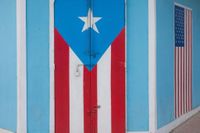Puerto Rico, an island long defined by its vibrant culture and complex relationship with the United States, is once again at the center of a debate over language, education, and economic opportunity. In recent weeks, two seemingly unrelated stories—Bad Bunny’s record-shattering residency and renewed calls for English to become the island’s dominant language—have converged to highlight the intricate ties between identity, policy, and prosperity in this U.S. territory of 3.2 million residents.
On September 23, 2025, SAN reported that Bad Bunny’s recent residency in Puerto Rico generated a staggering $400 million for the local economy, nearly doubling initial forecasts. The global superstar’s world tour, notably skipping the United States due to deportation concerns, further underscored his deep connection to the island and its people. Bad Bunny’s pride in his heritage is unmistakable. As quoted in The Latino Newsletter, he proclaims, “Pero soy cultura De Borinquen, PR, Archipiélago Perfecto; En el mundo entero ya conocen mi dialecto, mi jerga.” ("But I am the culture of Borinquen, PR, the Perfect Archipelago; the whole world already knows my dialect, my slang.")
His words echo a broader sentiment on the island, where language is more than a means of communication—it is a living symbol of identity. Yet, Puerto Rico’s relationship with language has always been fraught with tension. Since Spain ceded the island to the United States in 1898, successive governments have attempted to impose English-only education, often framing it as a step toward unity and progress. These efforts, as detailed in a September 24, 2025, opinion piece in The Latino Newsletter, have consistently failed, leading to increased dropout rates and confusion among students.
“Growing up in Puerto Rico, I heard the same advice from my grandmother that echoes through countless families on the island: ‘Be bilingual and you’ll have the opportunities we didn’t have,’” writes Viviana M. Vélez Negrón, a Ph.D. student at the University of Michigan and co-author of the opinion piece. This generational wisdom captures the delicate balancing act faced by Puerto Ricans—preserving their Spanish-speaking identity while seeking access to the opportunities that English proficiency can bring in a U.S. territory.
The drive to promote English as a symbol of national unity has been justified under the banner of “E Pluribus Unum,” yet the reality on the ground is far more nuanced. According to recent studies by Milagros González-Rivera, most Puerto Ricans view Spanish as central to their identity and reject the notion that bilingualism threatens their culture. “The findings are clear: Puerto Ricans want both languages, and not a forced choice between them,” the opinion piece notes.
Despite this, the island’s government continues to roll out language policies without adequately consulting local academic resources, such as the University of Puerto Rico. This disconnect has led to a crisis in both research and education, as repeated funding cuts have stymied progress and delayed much-needed reforms. Scholars like Guzzardo-Tamargo, whose 2024 study at the University of Puerto Rico delves into the complexities of the island’s language landscape, argue that their findings should inform government planning—yet too often, they do not.
The stakes of this debate have only grown in the wake of the COVID-19 pandemic. According to the National Center for Disaster Preparedness, Puerto Rican students suffered significant setbacks in language and literacy development during prolonged school closures. The pandemic exposed and exacerbated existing gaps, making the need for thoughtful, evidence-based language policies even more urgent. As the opinion piece in The Latino Newsletter puts it, “Puerto Rico needs education policies and systematic changes that foster genuine opportunities without sacrificing the cultural foundation that defines the island.”
For many families, the benefits of bilingual education are clear and tangible. Wendy de los Reyes, an Assistant Professor at Claremont McKenna College and co-author of the opinion piece, shares her personal experience: “As the mother of a young child in a U.S. bilingual public school, I see daily the ease with which my son switches between English and Spanish. I don’t have to choose between my child’s future opportunities and preserving our language and culture.”
This desire for both opportunity and cultural preservation is not unique to Puerto Rico, but the island’s history of forced assimilation policies has left deep scars. Since the turn of the twentieth century, political ideology rather than educational research has often driven language policy. The result? Repeated cycles of reform and backlash, with students and families caught in the crossfire. The opinion piece argues that a true interpretation of “E Pluribus Unum” would mean strengthening Puerto Rican identity while also supporting participation in the broader U.S. context.
Research in the United States consistently demonstrates the benefits of bilingual education for language and literacy development. Yet, Puerto Rico’s government has often neglected these findings, opting instead for top-down policies that ignore the lived realities of students and teachers. The authors of the opinion piece call for greater collaboration between institutions like the University of Puerto Rico and policymakers, emphasizing the need to gather data, plan, implement, and track bilingual education programs that build on the island’s linguistic strengths.
The economic impact of cultural pride and language is not just theoretical—it is vividly illustrated by Bad Bunny’s success. His $400 million residency not only provided a much-needed boost to Puerto Rico’s economy but also served as a powerful reminder of the global reach of Puerto Rican culture. According to SAN, the residency nearly doubled initial forecasts, a testament to the artist’s popularity and the island’s enduring appeal.
However, Bad Bunny’s decision to skip the United States on his world tour due to deportation concerns adds another layer to the conversation. It highlights the unique challenges faced by Puerto Ricans, who are U.S. citizens but often feel marginalized by federal policies and political debates over their status. The intersection of language, identity, and opportunity is not just an academic issue—it has real-world consequences for individuals and communities.
As Puerto Rico looks to the future, the path forward will require a careful balancing act. The solution, according to the authors of the opinion piece, lies “not in choosing one language over another, but in developing evidence-based bilingual programs that build on Puerto Ricans’ linguistic strengths.” This approach, they argue, can expand opportunities without ignoring the deep cultural connections that define the island.
From grandmothers’ advice to the global success of artists like Bad Bunny, the message is clear: Puerto Rico’s strength lies in its ability to embrace both tradition and change. The island’s ongoing debates over language and identity are far from settled, but one thing is certain—its people will continue to chart their own course, drawing on the best of both worlds.




